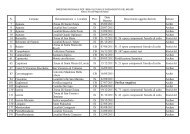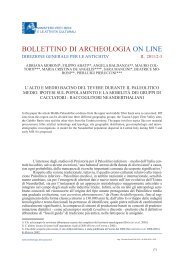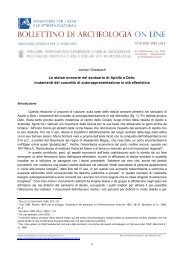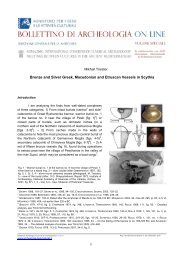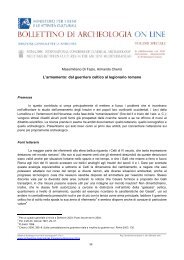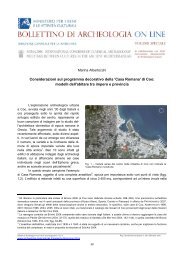Late Hellenistic Settlements in Hawrān (Southern Syria). Survival of ...
Late Hellenistic Settlements in Hawrān (Southern Syria). Survival of ...
Late Hellenistic Settlements in Hawrān (Southern Syria). Survival of ...
You also want an ePaper? Increase the reach of your titles
YUMPU automatically turns print PDFs into web optimized ePapers that Google loves.
J. Rohmer - <strong>Late</strong> <strong>Hellenistic</strong> <strong>Settlements</strong> <strong>in</strong> Hawrân (<strong>Southern</strong> <strong>Syria</strong>). <strong>Survival</strong> <strong>of</strong> Proto-historic Urbanism and Village Architecture <strong>in</strong> a Hellenized<br />
Context<br />
Apart from these major tells, smaller s<strong>in</strong>gle-period agglomerations provide <strong>in</strong>sight <strong>in</strong>to local trends <strong>in</strong><br />
town-plann<strong>in</strong>g and village architecture at the end <strong>of</strong> the <strong>Hellenistic</strong> period. Located on the western border <strong>of</strong><br />
the Leja, the agglomeration <strong>of</strong> Kreim aj-Janoûbi probably had a short-lived occupation dur<strong>in</strong>g the 1 st c. BC<br />
and maybe the first half <strong>of</strong> the 1 st c. AD (fig. 5) 27 . It is a 2.5 ha oval settlement (200 x 140 m) located on a<br />
basaltic platform, 1 km far from the agricultural plateau <strong>of</strong> Jedur. It is surrounded by an impressive double<br />
wall. The 5 to 7 m wide space between the outer and the <strong>in</strong>ner wall is filled with blocks, which may<br />
correspond either to collapsed build<strong>in</strong>gs or to a slop<strong>in</strong>g glacis. Besides, it is uncerta<strong>in</strong> yet whether the <strong>in</strong>ner<br />
wall was entirely filled with rubble or whether it had <strong>in</strong>ternal casemates at some po<strong>in</strong>ts <strong>of</strong> its course. Inside<br />
the settlement, a large depression corresponds to an ancient water reservoir, which, accord<strong>in</strong>g to the locals,<br />
was connected to an underground spr<strong>in</strong>g before it was blocked up by the Ottoman army. The <strong>in</strong>terior <strong>of</strong> the<br />
agglomeration is occupied by wide houses with courtyards or enclosures. Surface pottery f<strong>in</strong>ds <strong>in</strong>cluded a<br />
Greco-italic amphora <strong>of</strong> the 1 st c. BC<br />
and many pa<strong>in</strong>ted sherds (jugs, jars)<br />
which may have been imported from<br />
the neighbour<strong>in</strong>g regions <strong>of</strong> Golan or<br />
Galilee 28 .<br />
The nearby site <strong>of</strong> Khirbet<br />
‘Arish has a different layout (fig. 6). It<br />
is located on a basaltic platform <strong>in</strong> a<br />
very rocky environment, 1.5 km away<br />
from the nearest agricultural lands.<br />
Here, several rectangular pillared<br />
rooms with partition walls were built<br />
on the edge <strong>of</strong> the platform. All <strong>of</strong><br />
them open towards the <strong>in</strong>terior <strong>of</strong> the<br />
settlement, and most <strong>of</strong> them form<br />
several clusters (houses?) organised<br />
around common courtyards. The<br />
outer walls <strong>of</strong> the rooms are bl<strong>in</strong>d<br />
and were connected by segments <strong>of</strong><br />
walls <strong>in</strong> order to form a cont<strong>in</strong>uous<br />
“rampart.” The enclosed area covers<br />
approximately 0.8 ha (160 X 65 m).<br />
Only one house, with a front courtyard,<br />
is built outside <strong>of</strong> this rampart.<br />
The surface material conta<strong>in</strong>s a large proportion <strong>of</strong> imported pa<strong>in</strong>ted pottery, similar to that found <strong>in</strong> Kreim. It<br />
suggests a short-lived occupation <strong>in</strong> the 1 st c. BC and the first half <strong>of</strong> the 1 st Fig. 6 – Khirbet 'Arish: schematic plan <strong>of</strong> the visible rema<strong>in</strong>s.<br />
c. AD.<br />
The other <strong>Hellenistic</strong> or “pre-prov<strong>in</strong>cial” sites <strong>of</strong> Trachonitis have been significantly reoccupied <strong>in</strong> the<br />
Roman and Byzant<strong>in</strong>e periods. Consequently, there are very few clues to their <strong>in</strong>itial organization.<br />
Discussion<br />
An Anachronistic Architectural Morphology?<br />
Although they vary <strong>in</strong> size and shape, the settlements described share some basic common<br />
features. All <strong>of</strong> them are built on heights - promontories, tells or basaltic platforms. They cover the entire<br />
27 ROHMER 2010, 130–131.<br />
28 RENEL 2010a.<br />
Bollett<strong>in</strong>o di Archeologia on l<strong>in</strong>e I 2010/ Volume speciale G / G5 / 2 Reg. Tribunale Roma 05.08.2010 n. 330 ISSN 2039 - 0076<br />
www.archeologia.beniculturali.it<br />
6




